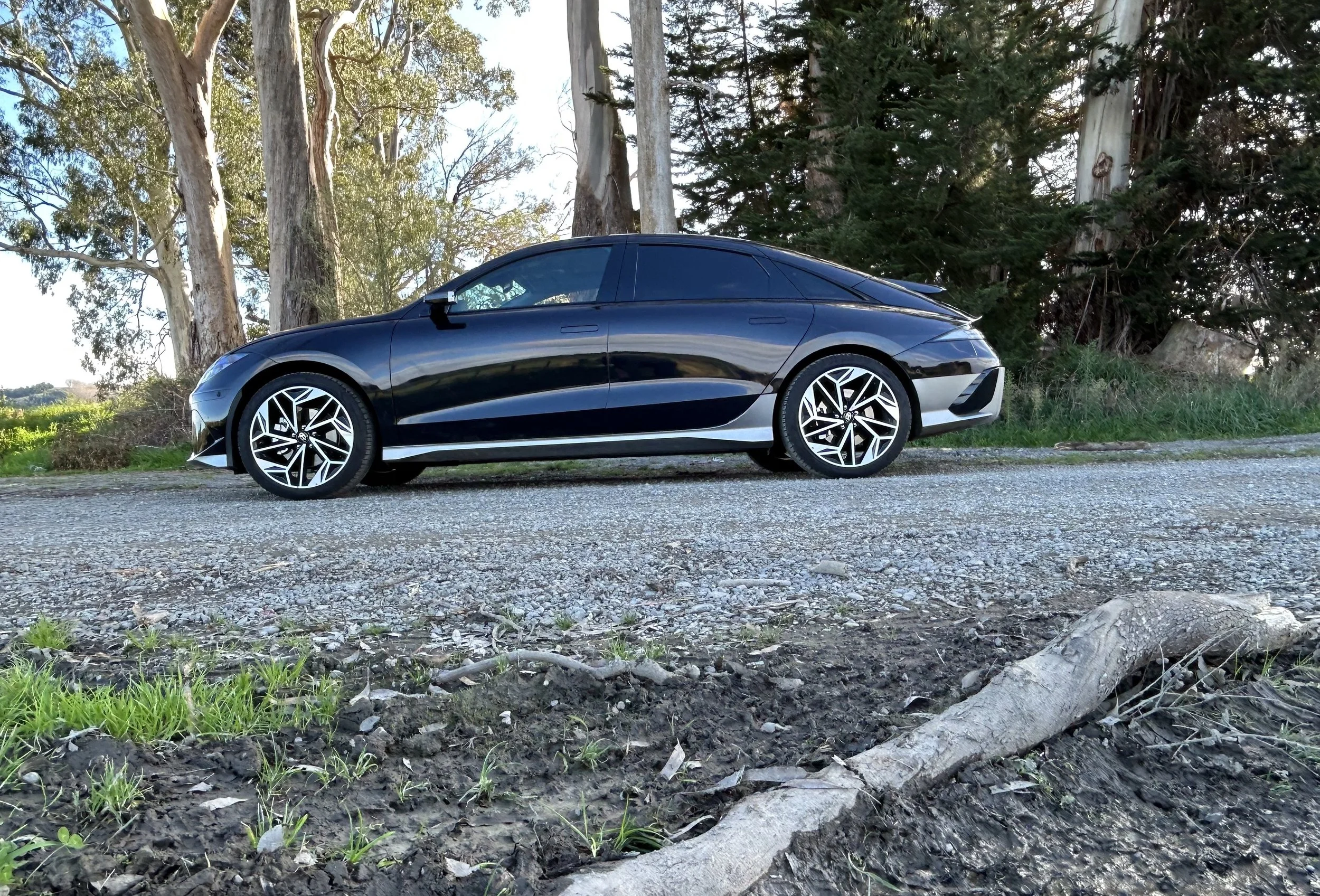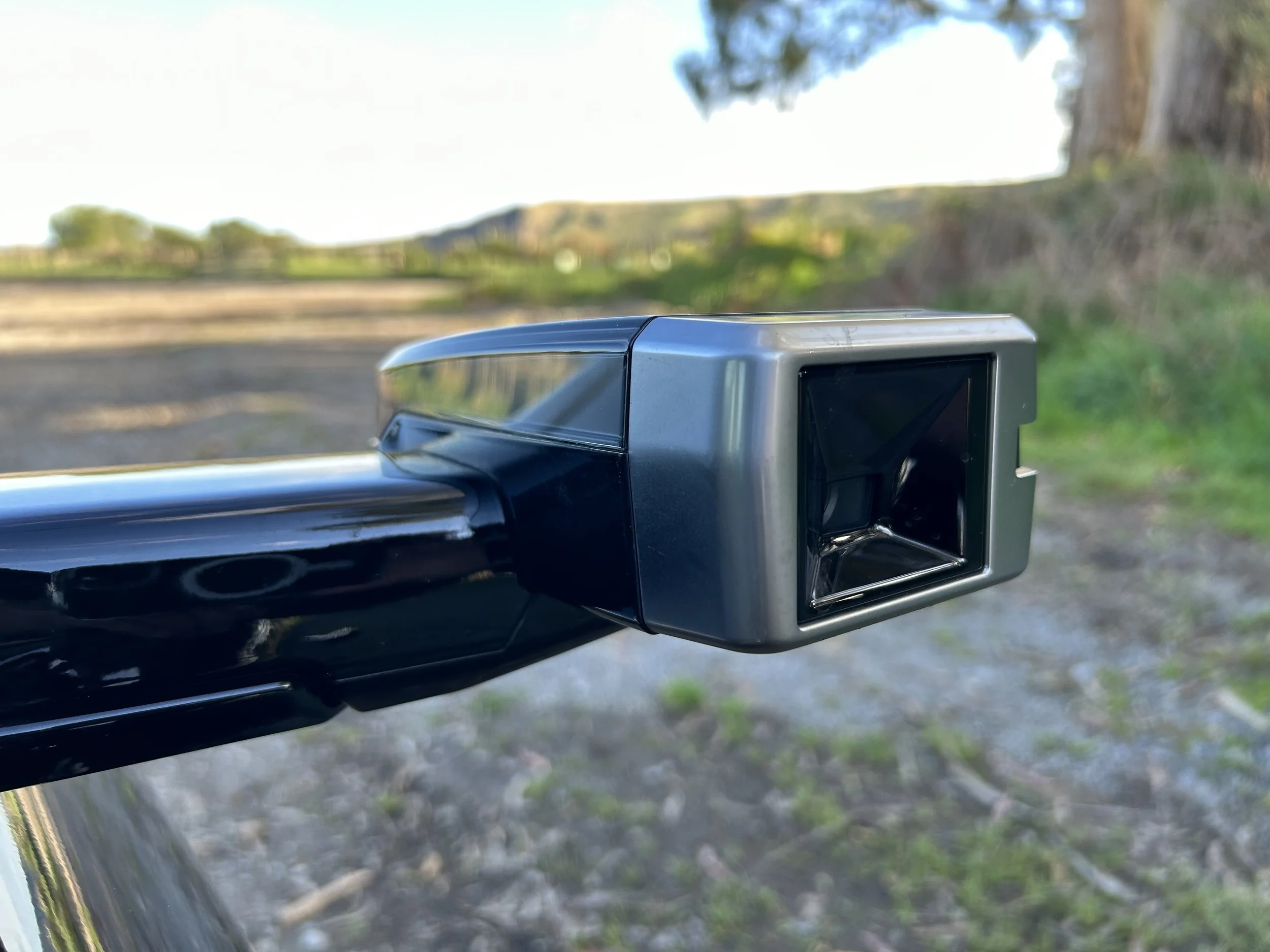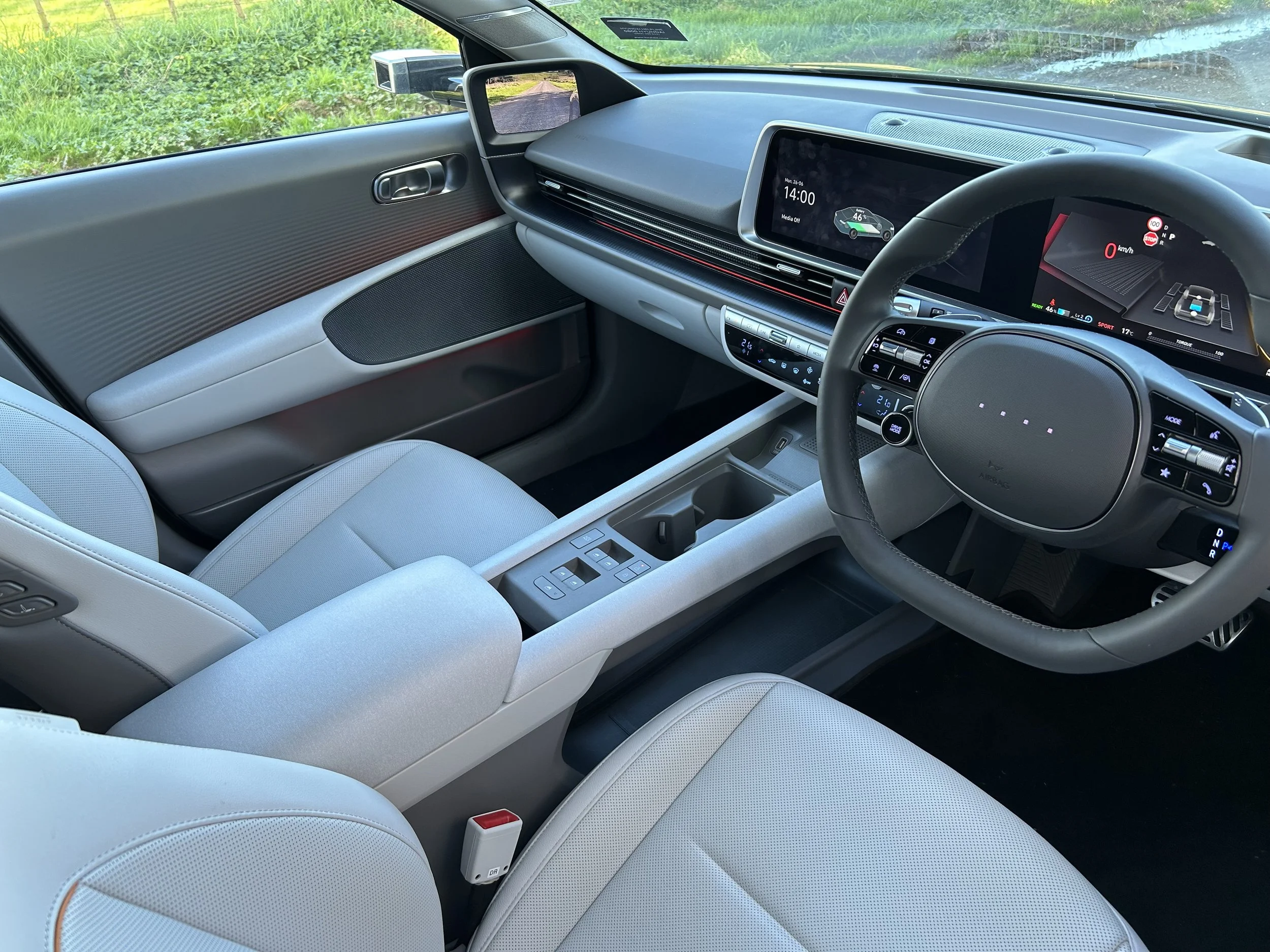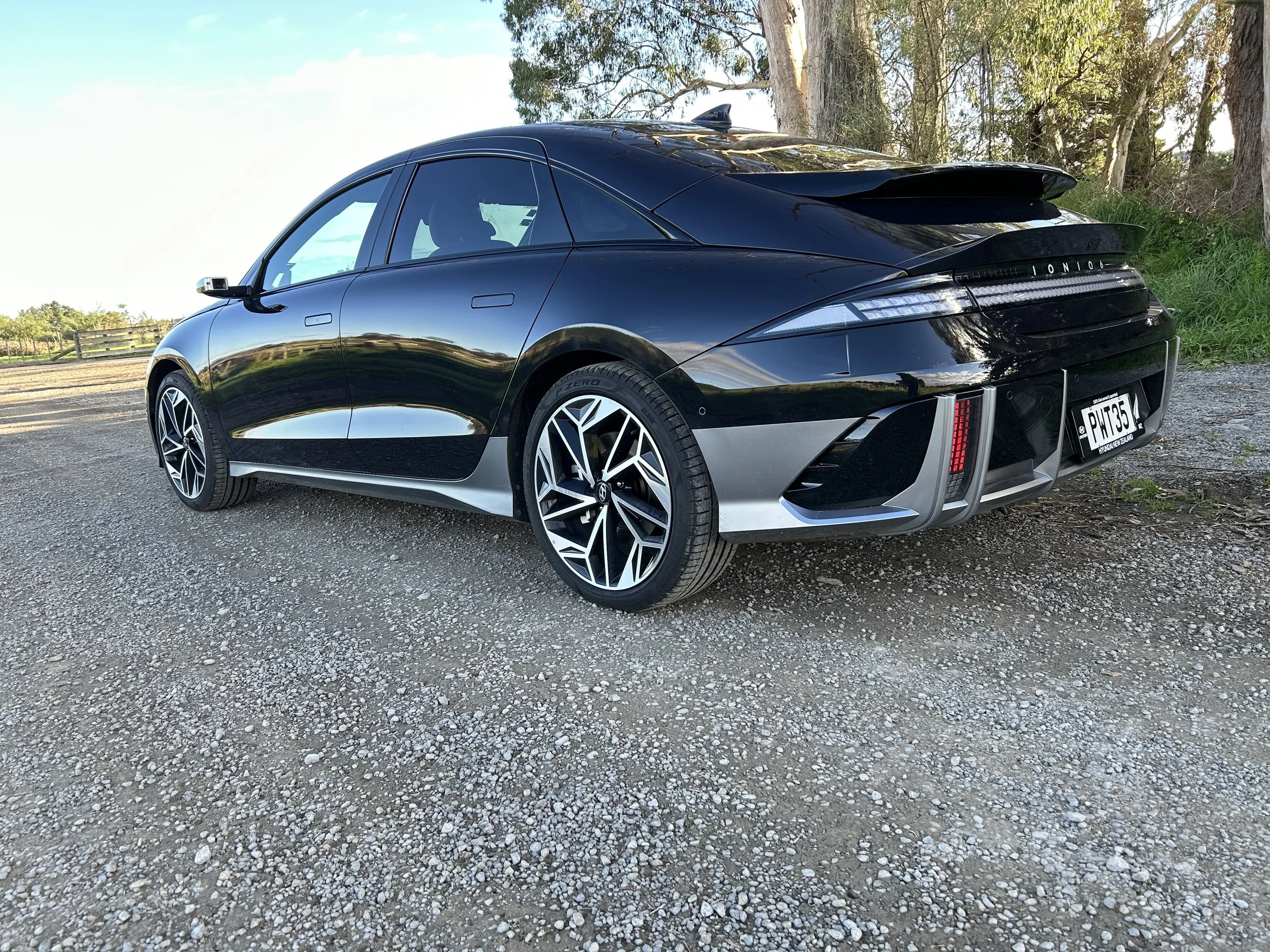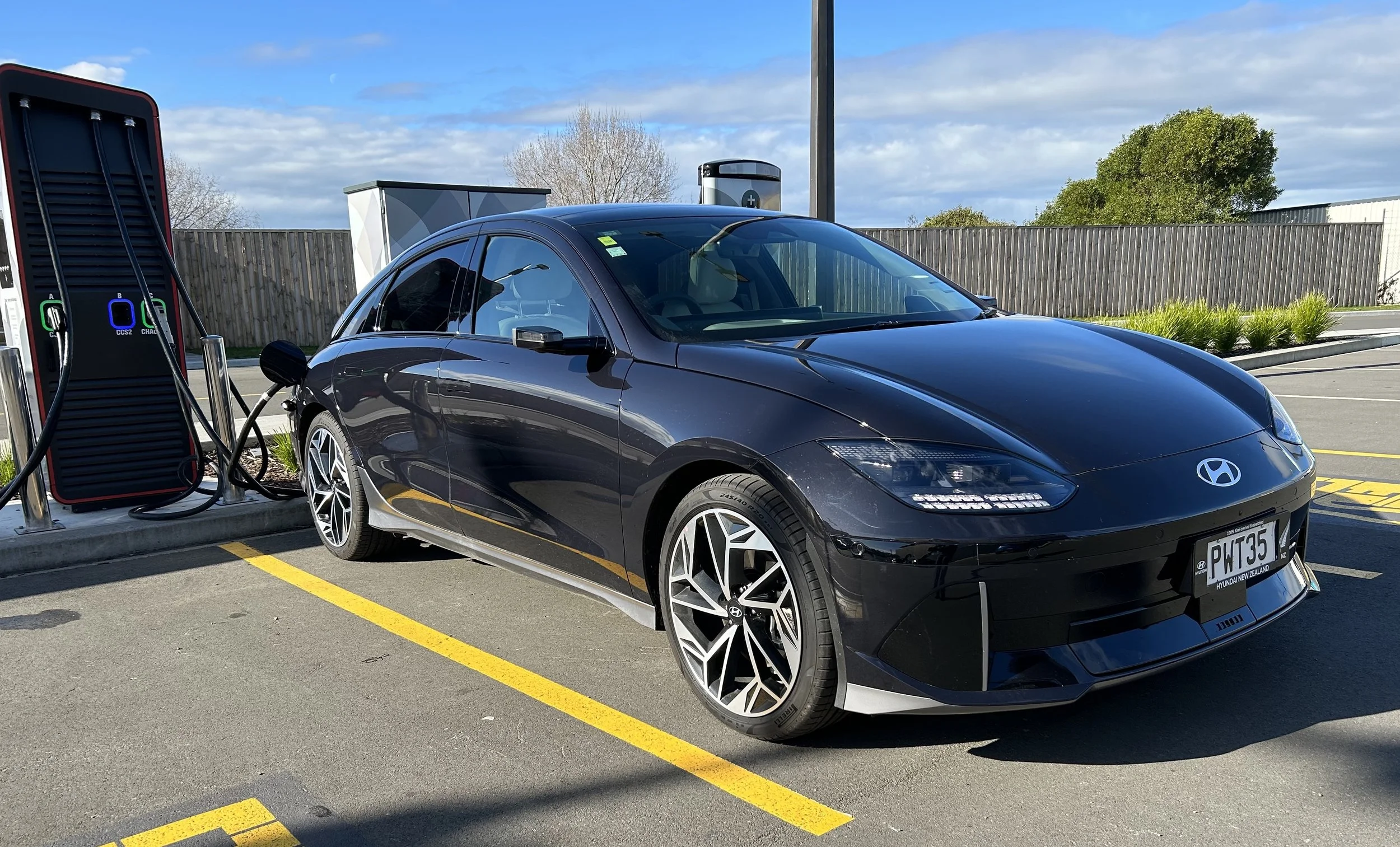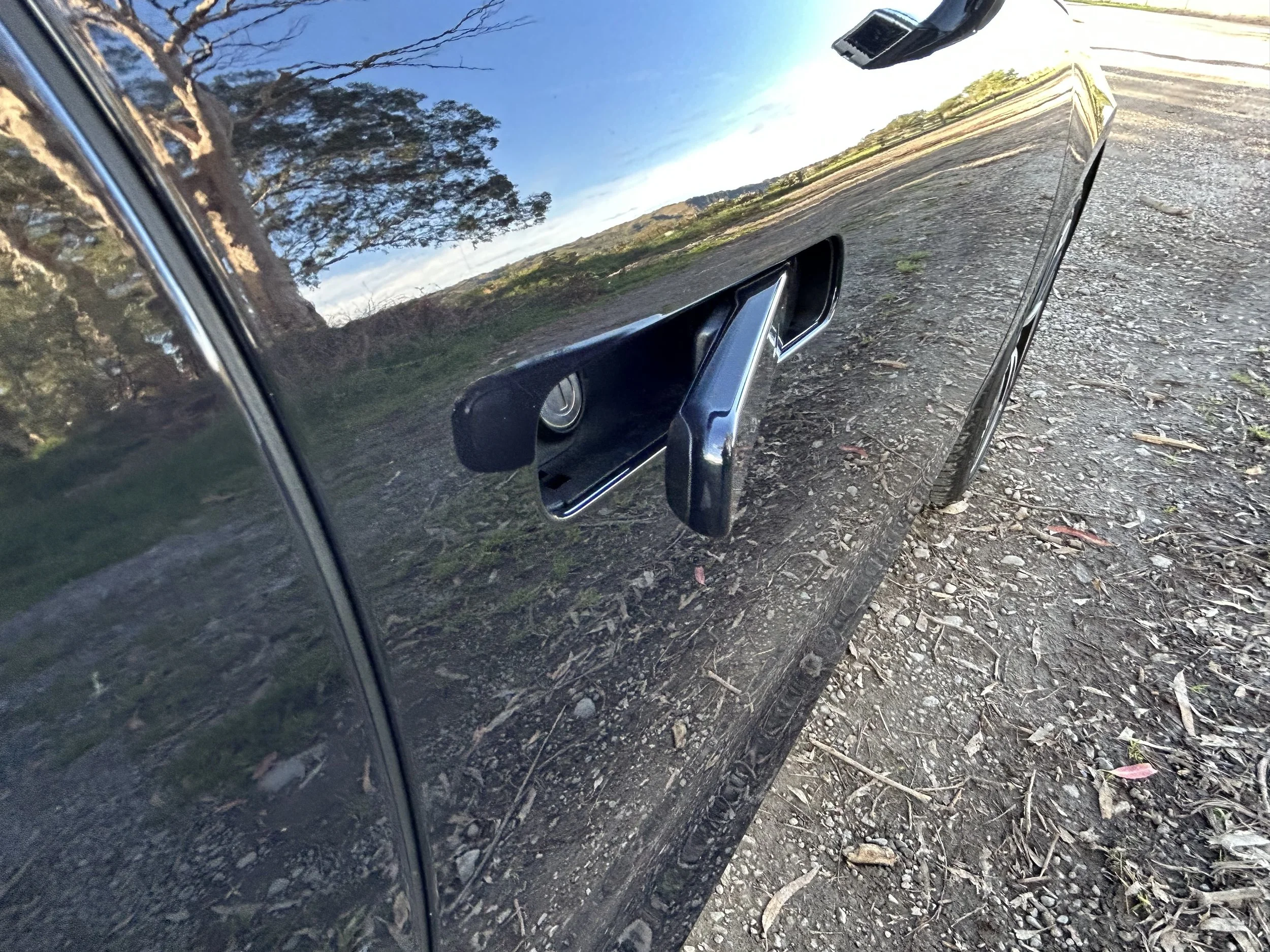Hyundai Ioniq 6 Limited first drive review: Quick, quiet and slightly irky quirky
/It looks like nothing else and represents as a quality cruiser, but there’s one bleeping thing to fix.
Price: $124,900.
Powertrain: dual electric motor with 77.4kWh battery, 239kW power and 605Nm torque, all wheel drive, 16.9kWh per 100km cited economy.
Vital statistics: 4855mm long, 1880mm wide, 1495mm high, 2950mm wheelbase, 401 litres luggage capacity, 245/40 R20 tyres.
We like: Bold design; strong performance; highly credible long-distance cruiser; quality build.
Not so much: Massively annoying speed warning; hatch more practical and roomier; prices above against most obvious rival.
NO end of fascinations and delights await anyone who is buying into Hyundai’s latest electric - so such a shame there’s one bleeping annoyance so front and centre it’s best to address it straight up.
Lane centring, lane keep, impact alerts … cars of today are equipped with a plethora of driving assists. Crash test safety auditors love this stuff - it’s a requirement, now, simply to even be considered for the top five-star status from an ANCAP crash test report - and you can bet your insurance providers love this stuff as well. Ioniq 6 fits out accordingly and, truly, I don’t mind the intent. Except when the tuning goes awry.
With this car, Hyundai has altered the speed warning software’s sensitivity to point where you need only get a sniff above a posted limit and it’s sounding off. It’s 10 times more trigger-happy than it configures in the other E-GMP platformed cars (Ioniq 5, Kia EV6) I’ve driven, apparently to meet an updated regulation in another market - not sure where, likely Europe.
So you just drive to the limits, right? Well, yes, you do. But there’s still the other ‘thing’ of it having speed sign recognition which has a mind of its own.
No, truly. Propensity to invent limits was a definite thing with this car. out of the blue in a 100kmh zone, it determined the limit was 50. On three consecutive days, when leaving an address in a 50kmh sector, in insisted the road I was entering had a 10kmh limit. Another fantasy, of course. And so on. It became bleeping tiresome.
Why not just turn it off? Well, yes, it can be deactivated, but that’s multiple step process and needs to be repeated for each and every driving occasion. A button on the dashboard that circumvents it permanently would be a Godsend. Hyundai NZ says that’s factory decision. there’s no homegrown solution.
It’s hugely frustrating that a function whose intention is good should become so bleeping bothersome as to bleeping taint the whole bleeping experience, not least in when so much else about that involvement is pretty bleeping good.
Sure, the Six demands a buyer with a certain degree of … well confidence.
The Ioniq design direction seemed bold with the Five - which Hyundai determines to be a sports utility but which you might view as I do, as a very large hatchback - but the sedan regardless of being on the same E-GMP architecture and with the same hardware, software and powertrains presents as a stronger car, particularly in look but also in air. With this car, everything in the seems to have been engineered just that little bit more. You notice this in how it drives but, even more, in respect to the refinement, which is very much a strong suit.
The design will captivate or alienate, simple as that. As with so much else about this car, it doesn’t push beyond the bounds of convention. Yet the development crew’s enthusiasm for stretching boundaries is very obvious. Astounding looking electric cars are becoming the norm, but even so, this one really stands out even in that growing crowd.
As radical as the computer mouse silhouette is, the whole thing is very artfully done. It also looked especially decent in as presented for test, with a glossy black paintwork and silver highlights. So much better than a light colour, for some reason, but enough to change a view formed at the launch about the Five being a better-looking car.
Aerodynamic efficiency is always important to any car, but moreso when it’s an electric. Here, they’re the whole reason for this shape. A drag co-efficiency of 0.21 is a Six status which this Limited, by virtue of having 20 inch rims, doesn’t quite achieve - it’s at 0.22, so the same as the Mercedes EQE, whose look is also dictated by wind tunnel analysis. Either way, those counts are really, really low and benefits in this car having considerably greater range than than the blocky Five.
And yet, for all that, you’ll have to get used to people still offering view that, if not the look in general, then some of the detailing, is as bit smart-arsey.
I’d agree in respect to this model’s use of stalk-mounted video camera as substitutes for wing mirrors. Are they better? In daytime, possibly. The imagery is crystal-sharp then. But they are much less convincing at night, as the headlights of anything following just overwhelm the display.
Transferring your attention to the view display panels within the cabin isn’t a matter of a moment, as your natural preference is to look outside to the camera pods proper, which site where conventional mirrors would otherwise locate. The part of me that always fears vandalism of such showy apparatus makes me wonder if it would have been smarter, perhaps, for Hyundai to have installed them in conventional mirror shrouds.
The design in general though, is a matter of wonderment; everything is so beautifully done. I expected to hear more feedback about the rear end, because of how it illuminates at night but also due to the two different spoiler-like features, given they’re really not possible to ignore. The one at the trailing edge of the heavily-sloped rear window is very Porsche 930 Turbo reminiscent, right down to having imprints on its top edge which, though Hyundai claims are all part of the aero side of things, are also there to be suggesting of the Porker’s cooling slots.
As with the Five, it has flush-fitting door handles that demand some explanation of their operation to first-time users and dexterity thereafter and though it’s not as overly space-chippy in operation from behind the wheel as might be imagined, it is certainly very modern, with plenty of flair. Just how the Limited’s steering wheel has LED lights that flash and colour change for different functions – and signal ‘H’ in morse code on start-up - is something I enjoyed showing off and there’s impressive mood lighting.
On that subject, the car’s exterior lighting is also a signature, not least when you buy into the LED lamps. The Six accepts over-the-air software updates and some upcoming will be purely for lighting effect, the brand says.
The interior trim needs to be luxurious for the money being asked but whether Hyundai achieves that is questionable.
The ‘eco-leather’ trim is convincing, the plastics are pretty good and employing trims rendered from stuff like recycled fishing nets and sugar cane waste sends a good Green message without any cheapeness. Ambience-wise, it lacks the air affluence you can get from a European equivalent - the BMW i4 provides an obvious reference point in that respect - but it’s very nicely rendered and is impeccably assembled.
The sedan being almost 22 centimetre longer than the Five, and its roofline 10.5cm lower, does hamper headroom; the Limited having such a big sunroof cut out is only good for front seat occupants; those in the back have their heads below a solid roof.
I’m tall and found I could achieve a decent driving position but only with the seat base as low as it could go - which isn’t low enough - and with the seat back at more of a rake than I’d generally like. even then my head didn’t quite touch the roof lining but the gap was millimetric. The seat base being as high-set as in the Five, where the mandate was deliver an SUV-like experience, is the issue.
The back seat isn’t really comfy for me, either, but isn’t going to be too bad for adults up to 180cm tall. Friends within that range sat there comfortably and remarked approvingly about the very decent legroom, a benefit of the wheelbase.
Up front, it’s very Five-like in the double-screen layout using two 12.3-inch displays is the same, with the one in the middle again impressing for being easy to navigate and sensibly keeping switchgear for the dual-zone climate control below it, along with a physical volume knob and other shortcut buttons for the system.
Specification is good at base, naturally a lot richer when you spend more. All models have sat nav and Apple CarPlay and Android Auto, decent stereos (though only the high-end model has Bose premium, with eight rather than six speakers) and dual zone air con (with a heat pump from Elite upward). Leather is only for the biggest spender, likewise heated and ventilated front and rear seats, and a heated steering wheel.
Cabin storage is generous. The flying bridge centre console liberates lots of space, and the drawer-type glove box is an example of design brilliance. There are door bins all-round and seat-back pockets as well.
Unlike in the Five, the centre console doesn't move. It's a two-level design with a rubberised wireless charging pad, USB-A port and cupholders up top and a large storage area underneath with a 12-volt socket.
Notwithstanding the charging pad’s location and usefulness, with the phone link not being wireless makes it pointless. Likewise that there’s a USB-C port in the storage box under the armrest, but not ahead of the induction pad; the one there instead being the older type. So, basically, it’s behind the times on two fronts. For me, it would seem more logical to plug your phone in under the armrest, where it cannot be seen, and in marriage to the infotainment rather than having it left out where it could be spotted. But that’s not possible as the USB-C is power only. So, really, a wireless hook-up would have been even better.
On subject of tech, I do like that Hyundai provisions V2L (Vehicle to Load) function, a feature most electric cars neglect will have within the next few years, and all but the base car get a socket for a normal three-pin plug, allowing you to power everyday devices from your car’s battery. Employment of a heat pump for more efficient cabin climate control and battery conditioning for faster DC charging is also note-worthy and laudable. This being an 800 volt car also shows benefit when you hook into a charger, particularly a 300kW type.
Interestingly, instead of being on the doors panels as per Ioniq 5, the electric window switches are also relocated to the centre console, which allows Hyundai to trim back the door cards and lend impression of roominess.
The squawking magpie speed and sign alert are small elements of a big spread of safety technology worthy of recognition. It is a shame only the priciest Six achieves the full provision with blind-spot warning system, an alert for pedestrians, cars and cyclists that you might be about to crash into, a system to keep you in your motorway lane and rear cross-traffic alert for reversing out into busy roads. A head-up display, surround parking camera and self-parking also restrict to the biggest spend. The latter can now operate in more situations including diagonal spaces and, as per Ioniq 5, the system also operates remotely from outside the car.
The Six’s headlining ability to achieve 600km-plus range is beyond Clean Car rebate reach and also not the remit of the test car; as while the Limited has the same battery as the ace derivative, it also in this top setting feeds dual motors. Whereas the range winner is a single motor car, in either base or Elite form.
How easily the special can hit its energy consumption rate of 13.9kWh/100km, which makes it one of the world’s most energy efficient production electric cars, would interesting to explore. Certainly, the Limited does not eke out quite so well, and the 525km optimal from a 100km charge seems a big stretch when this car was picked up with 97 percent battery life and cited range of 430km.
Yet the average of 18.3Kwh from test seemed acceptable, given where it was driven and how, with the Sport mode employed quite liberally on some fun roads.
The Six conveys a GT air. It’s clearly a ground-hugger and is treated at this level to swank 245/40 R20 Pirelli P Zero - albeit EV-specific - rubber, and benefits from having a stiffer three-box body and revised and firmer damper settings.
All of which make it feel tauter and sharper than the Five; the rear-favoured reactivity from that dual motor set-up is also obvious when performance settings are chosen.
Yet it also being a large and heavy item also factor into how it delivers; to point where despite the relativeness closeness in pricing and kit, you likely won’t see this is a booted alternate to a Kia EV6 GT.
The battery being slung low between the axles helps the centre of gravity, yet in respect to how it corners, grips and goes you’re not buying into Korea’s equivalent of a e-tron quattro. That you can amp up some artificial noise to make the powertrain more visceral really doesn’t hide the fact that it only takes playfulness so far.
Ride quality in the most sporting setting is firm, but there’s not a great deal of finesse. Our coarse chip is Hyundai’s misfortune, but I won’t be the first to suggest there is an argument here for adaptive dampers for the passive MacPherson strut/multi-link suspension set-up.
While the steering feel also lacks the absolute degree of communication that might seem desirable to in some circumstances, it is better modulated than the Five’s. Same goes for the braking feel. If this is evolution of Hyundai electrics in action, things can only get better.
Take it back a notch, though, and put it on a route that demands less involvement and it’s an appealing prospect; smooth, truly fast - remember, this is a car that’ll cap out 0-100kmh in 5.1 seconds - and extremely refined.
That Italian rubber does generate some coarse chip roar, but overall you’ll marvel at the quietness. It’s another EV in which conversations can be held at virtually whisper level at 100kmh. The ‘normal’ Drive setting is also nicely cushioned and you can set the cruise control and just let the car run. And run. And run. In that setting, it feels long-legged, compliant and confident.
The lane keep will, quite properly, only let you take your hands off he wheel for a few seconds, but the cruise control is properly clever, as it can automatically judge and deliver brake regeneration based on the speed of the vehicle ahead, following distance and navigation data.
If you do want to interact on that side, there are flappy paddles to manipulate the amount of involvement, from free-wheeling zero to full-on one-pedal braking.
Sensible driving will certainly pay off on the economy side; this car was topped up twice during its tenure but never out of absolute necessity.
It definitely has longer legs than the Five; even if just replenishing to 80 percent, on a decent long drive taken quietly you could be confident of it achieving 400kms plus between hook-ups.
While the Six is technically better resolved, overall, than the Five - which is also pretty good (it won NZ Car of the Year 2021, after all) - and has some nicer design elements, it is nowhere near as practical.
The low roofline isn’t the only challenge. The boot isn’t all that big anyway, but is also awkward in being long, wide and shallow, and the opening is oddly shaped. As a dual motor, Limited misses out on the 45-litre ‘wetbox’ trunk beneath the bonnet.
Also requiring consideration is the price. The Ioniq 6 will invariably be compared to the Tesla Model 3, but not when doing the pricing sums. The least expensive car, as a rebate winner, looks like it has a chance of achieving some mainstream interest, but you cannot imagine the pricier types will. Ioniqs are expensive and the sedan is dearer than the hatch. Watch out Tesla? Not really a threat Muskovites need take too seriously.
Still, that doesn’t mitigate against it standing out as an exceptionally interesting car and another example of how alluring electric technology is becoming, not least when it’s behind such a well-regarded badge.
But it’d be all the better without those bleeping bleeps.


